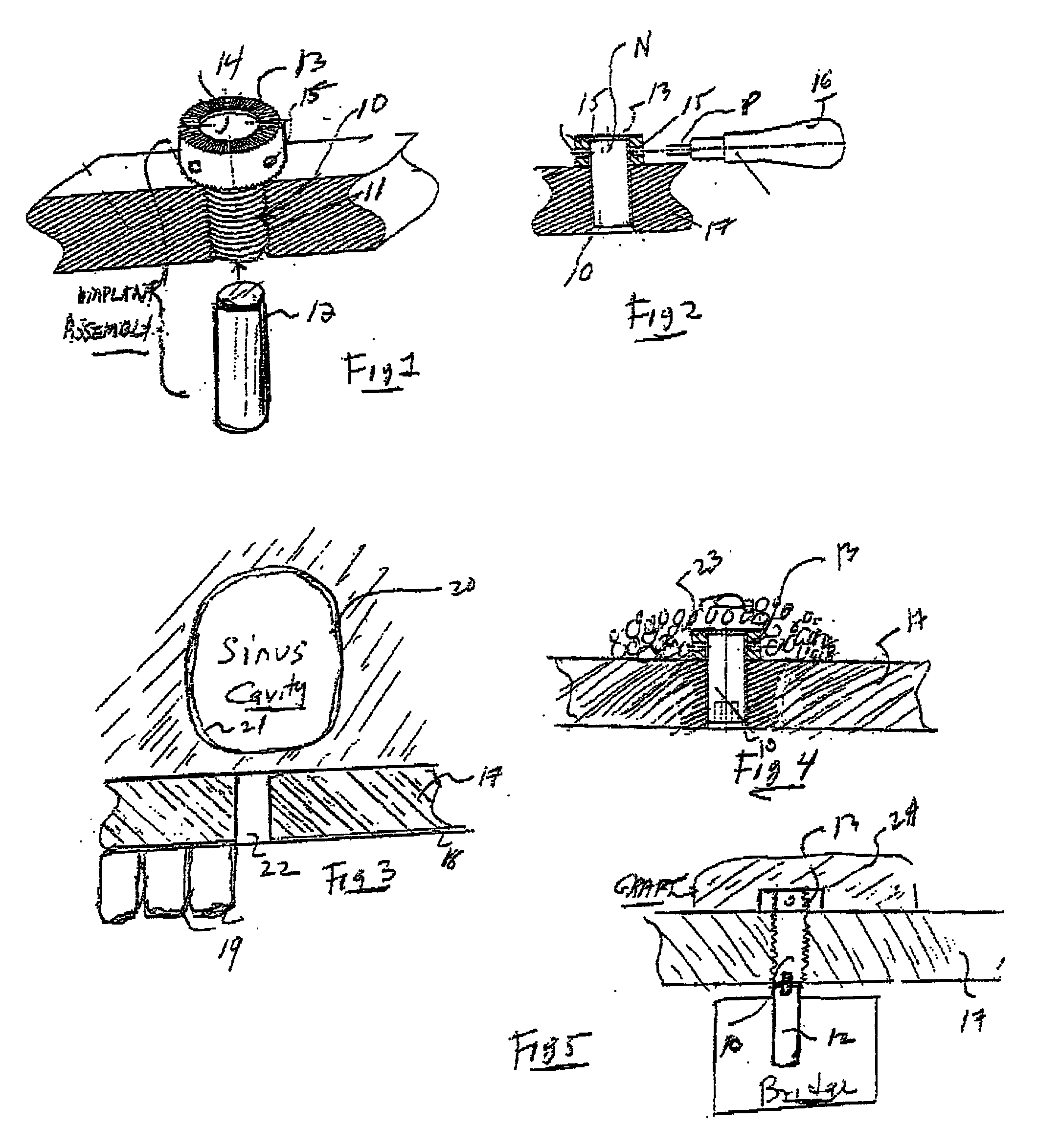Technique for installing dental implant assembly
a dental implant and assembly technology, applied in dentistry, dental surgery, medical science, etc., can solve the problems of reducing the feasibility of a maxillary dental implant, reabsorption of the bone surrounding the sinuses, and inability to meet the needs of patients,
- Summary
- Abstract
- Description
- Claims
- Application Information
AI Technical Summary
Benefits of technology
Problems solved by technology
Method used
Image
Examples
first embodiment
[0035] Referring now to FIG. 1 shown therein is a dental implant assembly for installation in an augmented maxilla in accordance with the invention. The assembly is composed of the following three sections:
[0036] I. Root Section 10 formed by a cylindrical metal shank having an external threading 11 with a cutting edge defining a self-tapping screw which can be screwed into a hole bored in the maxilla.
[0037] II. Post Section 12 formed by an unthreaded metal rod which is attachable to the rear end of root section 10 and serves to support a dental bridge.
[0038] III. Nut Section 13 formed by a metal nut which screws onto a nose on the front end of root section 10 and is provided for this purpose with an internally threaded bore 14. This nut acts to lock the root section in place after being screwed into the bone hole.
[0039] Normally in order to hold or turn a nut on a threaded screw, one uses for this purpose a wrench whose head is adapted to socket the nut. But to engage the nut, the h...
second embodiment
[0057] In this embodiment which is illustrated in FIG. 6, we have a self-tapping threaded root section 25 which functions as a screw that is screwed into a hole 22 drilled in maxilla 17. Projecting from the upper end of root section 25 into the sinus cavity is a threaded nose N which is engaged by a nut 26 having radial holes therein to receive the prong of tool 16 shown in FIG. 2.
[0058] The treading of root section 25 whose shank diameter matches the diameter of drilled hole 22 is right-handed (clockwise), whereas the threading of nose N whose diameter is somewhat smaller than that of the root section is left-handed (counter-clockwise). Also counterclockwise is the internal threading of nut 26 received on the nose.
[0059] The underside of nut 26 is provided with a set of sharp projections or teeth 26T capable of cutting into bone. The purpose of the differential threading is to facilitate the penetration of the teeth into the maxilla so that it becomes embedded therein to resist unt...
third embodiment
[0064] In this embodiment which is illustrated in FIGS. 7, 8 and 9, the root section 27 of the assembly which is screwed into hole 22 bored in maxilla 17 is the same as the root section 25 in FIG. 6. However nose 28 which projects from root section 28 into the sinus cavity is not threaded but is formed by a cylindrical boss whose diameter is somewhat smaller than that of the root section. On the head of the boss is a circular flange 28F of large diameter.
[0065] In this assembly, the fastening or locking element section is not a nut as in the other embodiments but a rectangular metal block 29 having a U-shaped recess 29U defining a pair of arms A1 and A2.
[0066] The underside of block 29 is provided with projecting pins or teeth 29T. This locking element is simple to install, for one has only to slide it onto boss 28, as shown in FIG. 8 so that arms A1 and A2 of the block straddle the boss and underlie flange 28F.
[0067] Then the operator us in the counterclockwise direction the root s...
PUM
 Login to View More
Login to View More Abstract
Description
Claims
Application Information
 Login to View More
Login to View More - R&D
- Intellectual Property
- Life Sciences
- Materials
- Tech Scout
- Unparalleled Data Quality
- Higher Quality Content
- 60% Fewer Hallucinations
Browse by: Latest US Patents, China's latest patents, Technical Efficacy Thesaurus, Application Domain, Technology Topic, Popular Technical Reports.
© 2025 PatSnap. All rights reserved.Legal|Privacy policy|Modern Slavery Act Transparency Statement|Sitemap|About US| Contact US: help@patsnap.com



